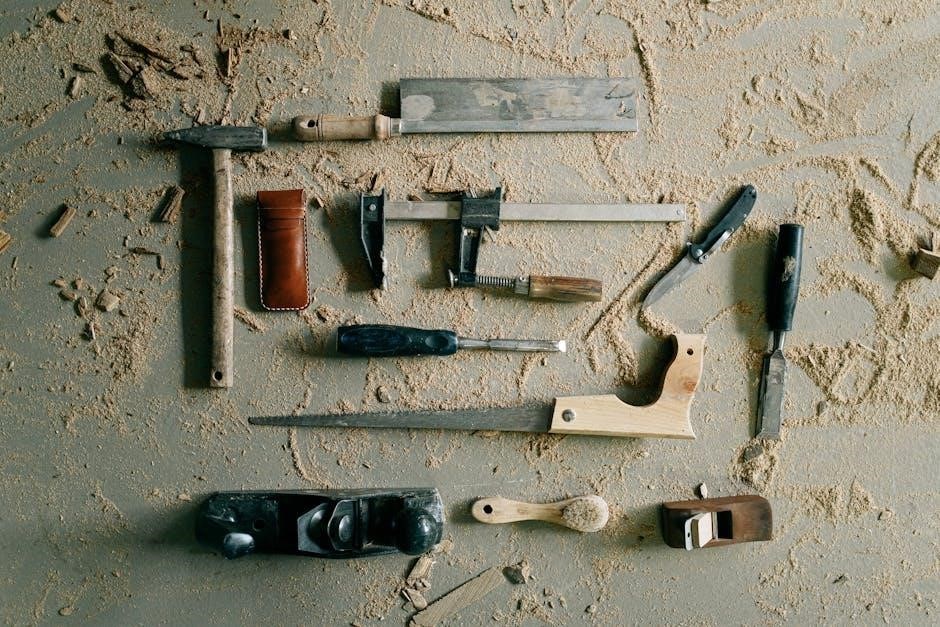A chisel honing guide is a tool designed to help woodworkers sharpen chisels accurately and efficiently. It ensures consistent bevel angles, making the sharpening process precise and reliable. Unlike freehand sharpening, a honing guide provides stability and control, helping both beginners and professionals achieve razor-sharp edges effortlessly. This essential tool is a cornerstone for maintaining sharp, functional chisels in any woodworking workshop.
1.1 What is a Chisel Honing Guide?
A chisel honing guide is a specialized tool designed to assist in sharpening chisels. It helps maintain the correct angle and alignment during the sharpening process, ensuring consistent results. The guide typically attaches to the chisel and holds it securely against a sharpening stone, allowing for precise control. This tool is essential for achieving sharp, even edges and is widely used by woodworkers and craftsmen to maintain their tools effectively.
1.2 Importance of Sharpening Chisels
Sharpening chisels is crucial for ensuring precision, safety, and efficiency in woodworking. A dull chisel can lead to poor work quality, increased effort, and potential accidents. Regular sharpening maintains the tool’s effectiveness, prolongs its lifespan, and enhances overall craftsmanship. A sharp chisel is essential for clean cuts and accurate results, making it a fundamental skill for any woodworker or craftsman to master and maintain.

Choosing the Right Honing Guide
Selecting the right honing guide depends on your specific needs, ensuring durability, ease of use, and adjustability. It should accommodate various chisel sizes and types, providing precision and consistency in sharpening. The right tool simplifies the process, making it faster and more effective for achieving sharp, reliable edges.
2.1 Types of Honing Guides Available
Several types of honing guides are available, including Eclipse-style guides, precision engineering guides like Garrett Wade’s Chisel Doctor, and budget-friendly Chinese versions. Each offers unique features, such as adjustable angle settings, durability, and ease of use. Some guides are designed for specific chisel sizes or types, while others are versatile for various tools. Choosing the right one depends on your needs and budget.
2.2 Features to Look for in a Honing Guide
Key features include precise angle adjustment, sturdy construction, and easy chisel alignment. Look for guides with built-in angle measures or digital readouts for accuracy. Durability and smooth operation are crucial, as well as compatibility with various chisel sizes. Some guides offer additional tools, like integrated stone holders, enhancing convenience. Ensure the guide is user-friendly and provides consistent results for optimal sharpening efficiency.

Step-by-Step Guide to Using a Honing Guide
Start by preparing the chisel and setting the correct angle. Secure it in the guide, then use a smooth back-and-forth motion on the stone. After honing, polish the edge for sharpness.
3.1 Preparing the Chisel for Honing
Begin by flattening the chisel’s back using a coarse stone to ensure even contact. Clean the blade to remove any debris. Inspect for nicks or damage and lightly dress them. Secure the chisel in the honing guide, aligning the edge with the guide’s roller. Ensure the tool is tightly held to maintain stability during the sharpening process.
3.2 Setting the Correct Angle
Setting the correct angle is crucial for effective sharpening. Most chisels require a 20-30° bevel angle, depending on their type and use. Use a protractor or digital angle finder to verify accuracy. Adjust the honing guide by loosening the adjustment knob and aligning the blade to the desired angle. Ensure the guide is parallel to the sharpening stone for consistent results. This ensures precise, repeatable sharpening every time.
3.3 Honing Process: Back and Forth Motion
With the chisel securely held in the guide, apply light pressure and move it back and forth across the sharpening stone. Use a steady, controlled motion to maintain consistent contact. Apply finger pressure on the blade’s back to ensure squareness. Check progress periodically by inspecting the edge. This method ensures even wear and a sharp, precise edge. Maintain the correct angle throughout for optimal results.
3.4 Finishing Touches: Polishing the Edge
After honing, polish the edge using a fine-grit stone or a bench strop with green compound. Lightly draw the chisel across the surface, maintaining the established angle. This step removes micro-scratches and creates a razor-sharp, high-polish finish. Regular polishing enhances the chisel’s performance and ensures smooth, precise cuts in wood. Consistent upkeep prolongs the tool’s sharpness and reliability.

Advanced Techniques for Chisel Honing
Mastering advanced techniques like microbevel creation and adjusting bevel angles for different chisels can significantly enhance sharpening precision and tool performance for skilled woodworkers;
4.1 Achieving a Microbevel
Achieving a microbevel involves creating a small, secondary bevel at the edge of the chisel for enhanced precision and cutting performance. Using a honing guide, set the tool to a slightly steeper angle than the primary bevel. Lightly draw the chisel across a high-grit stone (8000 grit or higher) in smooth, controlled strokes. This technique ensures a sharp, durable edge ideal for fine woodworking tasks. Always inspect the microbevel under magnification to ensure accuracy and consistency.
4.2 Adjusting the Bevel Angle for Different Chisels
Adjusting the bevel angle is crucial for optimizing chisel performance. Bench chisels typically use a 25-30° bevel, while paring chisels may require a shallower 20-25° angle. Using a honing guide, set the angle by aligning the tool with the desired measurement. Light pressure ensures consistent contact with the stone. This customization enhances cutting efficiency and prevents damage to the chisel edge, ensuring precise results for various woodworking tasks.

Maintenance and Troubleshooting
Regularly clean and store the honing guide to prevent rust. Check alignment and tightness before use. Address slipping issues by ensuring the chisel is square and secure in the guide.
5.1 Cleaning and Storing the Honing Guide
Regular cleaning ensures optimal performance. Use a soft cloth to wipe away metal shavings and debris. Avoid harsh chemicals; instead, use mild soap and water. Dry thoroughly to prevent rust. Store in a cool, dry place, away from direct sunlight. Check for dust or debris before use and ensure all parts are secure. Proper storage maintains accuracy and extends the tool’s lifespan.
5.2 Common Issues and Solutions
Common issues include chisels slipping in the guide or incorrect angles. Tighten the guide firmly and ensure the chisel is square. For angle accuracy, use a digital angle finder. If the guide isn’t holding the chisel securely, check for wear and adjust or replace parts as needed. Regular maintenance prevents these issues, ensuring precise sharpening every time.

Budget-Friendly Honing Guide Options
Affordable honing guides, like the Chinese-rebranded models, offer excellent value. DIY alternatives, such as custom jigs, provide cost-effective solutions for sharpening chisels effectively without breaking the bank.
6.1 Affordable Honing Guides for Beginners
Affordable honing guides, like the Chinese-rebranded models, are ideal for beginners. Made from durable materials, they are easy to use and ensure consistent bevel angles. These guides offer great value, helping new users achieve sharp edges without the high cost, making them a reliable choice for starting a sharpening routine.
6.2 DIY Alternatives to Commercial Guides
For those on a budget, DIY alternatives like using a magnetic angle finder or clamps can serve as makeshift honing guides. These simple tools help maintain consistent angles while sharpening. By attaching a magnetized digital angle finder to the chisel, you can achieve precise control. DIY methods are cost-effective and adaptable, offering a practical solution for sharpening without investing in commercial guides.

Case Studies: Professional Sharpening Techniques
Professionals rely on honing guides to achieve precise, consistent results. Experts use high-quality guides to maintain sharp edges, ensuring optimal performance for intricate woodworking projects and precise cuts.
7.1 How Experts Use Honing Guides
Experts utilize honing guides to achieve precise control over chisel sharpening, ensuring consistent angles and razor-sharp edges. Many professionals employ digital angle finders for accuracy and rely on high-quality stones for polishing. By mastering guide setups, experts maintain optimal tool performance, enabling flawless cuts and enhancing woodworking project outcomes. Their techniques emphasize efficiency and precision, making honing guides indispensable in their workflows.
7.2 Real-World Applications and Results
Woodworkers report improved precision and efficiency using honing guides, achieving consistent angles and sharpness. Professionals highlight results like cleaner cuts, reduced waste, and enhanced tool longevity. High-grit finishes and microbevels are common outcomes, enabling superior woodworking results. These tools have proven indispensable for craftsmen, delivering professional-grade sharpness and reliability in various woodworking projects, from furniture making to intricate detailing.

Honing Guide vs. Freehand Sharpening
A honing guide offers precision and consistency, ideal for maintaining sharp edges with minimal effort. Freehand sharpening demands skill but allows for greater customization and adaptability during the process.
8.1 Pros and Cons of Each Method
Honing guides offer precision and consistency, making them ideal for beginners or those seeking uniform results. However, they may lack flexibility for custom angles. Freehand sharpening provides creativity and adaptability but requires significant skill and practice to master. Guides save time and effort, while freehand sharpening allows for direct control over the sharpening process, appealing to experienced craftsmen seeking exacting results.
8.2 When to Use a Honing Guide
A honing guide is ideal for maintaining consistent angles and precision, especially for beginners. Use it when sharpening high-quality chisels or delicate tools to avoid damage. It’s also perfect for achieving uniform results quickly and effortlessly. For those seeking polished finishes, a guide ensures the correct angle is maintained throughout the sharpening process, making it an invaluable tool for both hobbyists and professionals alike.

Honing Guide Accessories and Tools
Essential tools include diamond stones, angle finders, and storage cases. These accessories ensure precise sharpening and longevity of both chisels and guides for optimal results.
9.1 Essential Tools for Sharpening
Key tools for sharpening include waterstones, diamond stones, and honing guides. Waterstones are ideal for polishing edges, while diamond stones quickly repair damaged areas. A digital angle finder ensures precise bevel angles. Additionally, leather strops with sharpening compounds refine the edge, and a bench vice provides stability. These tools collectively enhance the sharpening process, ensuring sharp, reliable chisels for woodworking tasks.
9.2 Recommended Stones and compounds
9.2 Recommended Stones and Compounds
For optimal sharpening, use high-quality waterstones or diamond stones. Waterstones, available in varying grits, are excellent for polishing edges. Diamond stones are durable and ideal for repairing damaged areas. Apply green rouge compound on leather strops for final polishing. A progression from coarse to fine grit ensures a sharp, refined edge. These tools and compounds are essential for achieving professional-level sharpness in chisels.
Mastering chisel sharpening with a honing guide ensures consistency and precision. Regular practice and proper tool maintenance will keep your chisels sharp and your woodworking projects flawless. Consistency is key—sharp tools make all the difference in achieving professional results. Keep practicing to refine your skills and enjoy the satisfaction of perfectly honed edges.
10.1 Best Practices for Long-Term Sharpness
For long-term sharpness, store chisels in a dry place to prevent rust. Clean and maintain the honing guide regularly to ensure accuracy. Sharpen chisels before they become dull, as this reduces the effort required. Use high-quality sharpening stones and always check the guide’s alignment. Consistent practice and proper tool care will extend the life of your chisels and ensure optimal performance in every project.
10.2 Encouragement for Consistent Practice
Consistent practice with a chisel honing guide is key to mastering sharpening. Regular use builds skill and confidence, ensuring your tools stay sharp and perform optimally. Over time, sharpening becomes second nature, saving time and frustration. Embrace the process, and you’ll enjoy the satisfaction of working with razor-sharp chisels. Keep practicing—it’s worth the effort for professional-quality results every time.
